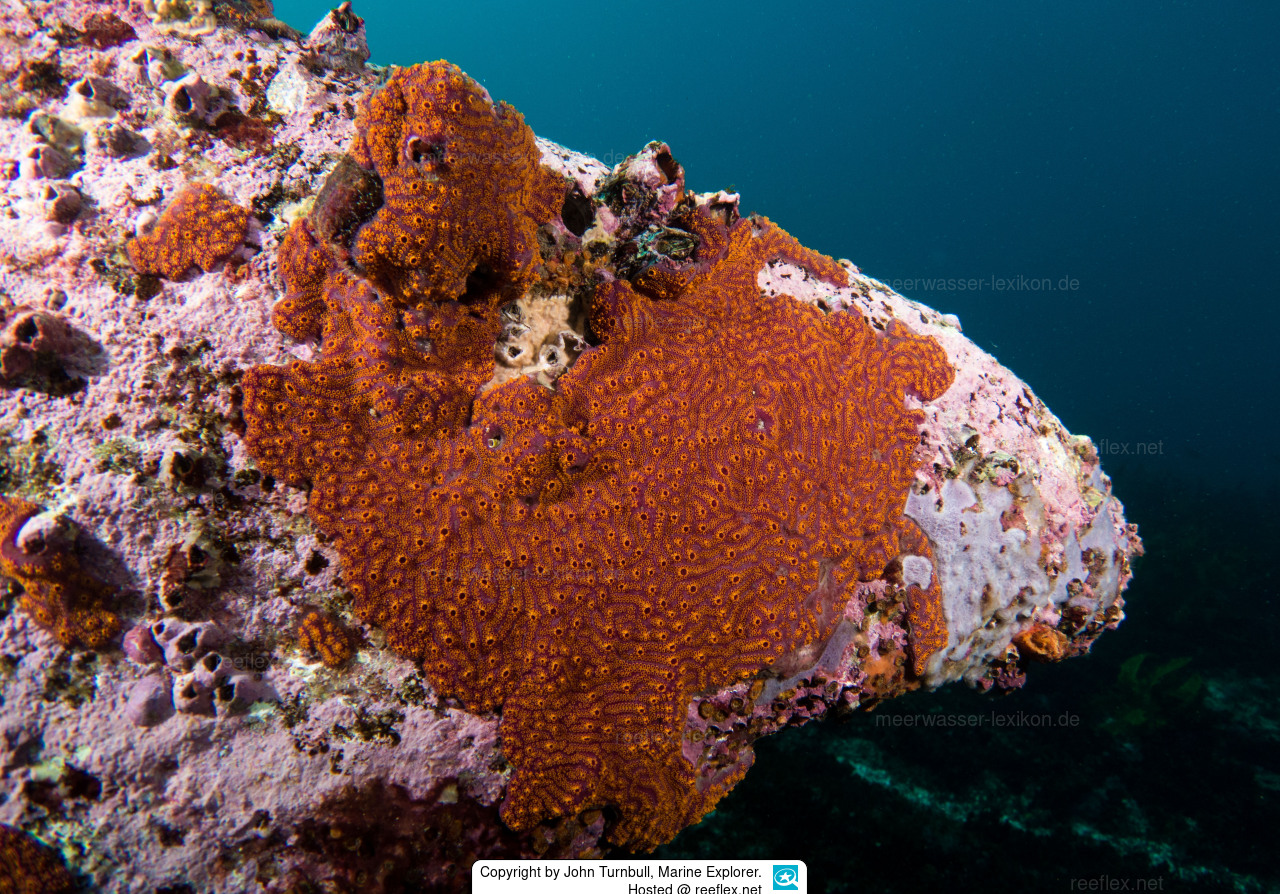Info
Botrylloides leachii (Savigny, 1816)
Botrylloides is an invasive species and today a cosmopolite with a powerful process of growth with hardly predators.
Synonymised names:
Botrylloides albicans Milne Edwards, 1841 · unaccepted (original combination)
Botrylloides boloniense Giard, 1875 · unaccepted (original combination)
Botrylloides clavelina Giard, 1872 · unaccepted (original combination)
Botrylloides cyanescens Giard, 1888 · unaccepted (original combination)
Botrylloides fulgurale Herdman, 1886 · unaccepted (original combination)
Botrylloides insigne Giard, 1872 · unaccepted (original combination)
Botrylloides leachi (Savigny, 1816) · unaccepted (literature misspelling)
Botrylloides leptum Herdman, 1899 · unaccepted (original combination)
Botrylloides parvulum Huitfeld-Kaas, 1896 · unaccepted (unjustified emendation)
Botrylloides parvulus Huitfeld-Kaas, 1896 · unaccepted (original combination)
Botrylloides prostratum Giard, 1872 · unaccepted (original combination)
Botrylloides purpureum Drasche, 1883 · unaccepted (junior homonym)
Botrylloides pusilla Alder, 1863 · unaccepted (original combination)
Botrylloides radiata Alder & Hancock, 1848 · unaccepted (original combination)
Botrylloides ramulosa Alder & Hancock, 1848 · unaccepted (original combination)
Botrylloides rotifera Milne Edwards, 1841 · unaccepted (original combination)
Botrylloides rubrum Milne Edwards, 1841 · unaccepted (original combination)
Botrylloides sparsa Alder, 1863 · unaccepted (original combination)
Botrylloides translucidum Hartmeyer, 1912 · unaccepted (original combination)
Botrylloides vinosa Alder & Hancock, 1912 · unaccepted (original combination)
Botryllus leachi Savigny, 1816 · unaccepted (literature misspelling)
Botryllus leachii (Savigny, 1816) · unaccepted (new combination)
Botryllus leptus (Herdman, 1899) · unaccepted (new combination)
Metrocarpa leachi (Savigny, 1816) · unaccepted (literature misspelling)
Sarcobotrylloides espevaerense Huitfeld-Kaas, 1896 · unaccepted (original combination)
Sarcobotrylloides jacksonianum Herdman, 1899 · unaccepted (original combination)
Sarcobotrylloides pannosum Herdman, 1899 · unaccepted (original combination)
Botrylloides is an invasive species and today a cosmopolite with a powerful process of growth with hardly predators.
Synonymised names:
Botrylloides albicans Milne Edwards, 1841 · unaccepted (original combination)
Botrylloides boloniense Giard, 1875 · unaccepted (original combination)
Botrylloides clavelina Giard, 1872 · unaccepted (original combination)
Botrylloides cyanescens Giard, 1888 · unaccepted (original combination)
Botrylloides fulgurale Herdman, 1886 · unaccepted (original combination)
Botrylloides insigne Giard, 1872 · unaccepted (original combination)
Botrylloides leachi (Savigny, 1816) · unaccepted (literature misspelling)
Botrylloides leptum Herdman, 1899 · unaccepted (original combination)
Botrylloides parvulum Huitfeld-Kaas, 1896 · unaccepted (unjustified emendation)
Botrylloides parvulus Huitfeld-Kaas, 1896 · unaccepted (original combination)
Botrylloides prostratum Giard, 1872 · unaccepted (original combination)
Botrylloides purpureum Drasche, 1883 · unaccepted (junior homonym)
Botrylloides pusilla Alder, 1863 · unaccepted (original combination)
Botrylloides radiata Alder & Hancock, 1848 · unaccepted (original combination)
Botrylloides ramulosa Alder & Hancock, 1848 · unaccepted (original combination)
Botrylloides rotifera Milne Edwards, 1841 · unaccepted (original combination)
Botrylloides rubrum Milne Edwards, 1841 · unaccepted (original combination)
Botrylloides sparsa Alder, 1863 · unaccepted (original combination)
Botrylloides translucidum Hartmeyer, 1912 · unaccepted (original combination)
Botrylloides vinosa Alder & Hancock, 1912 · unaccepted (original combination)
Botryllus leachi Savigny, 1816 · unaccepted (literature misspelling)
Botryllus leachii (Savigny, 1816) · unaccepted (new combination)
Botryllus leptus (Herdman, 1899) · unaccepted (new combination)
Metrocarpa leachi (Savigny, 1816) · unaccepted (literature misspelling)
Sarcobotrylloides espevaerense Huitfeld-Kaas, 1896 · unaccepted (original combination)
Sarcobotrylloides jacksonianum Herdman, 1899 · unaccepted (original combination)
Sarcobotrylloides pannosum Herdman, 1899 · unaccepted (original combination)







 John Turnbull, Marine Explorer, Australien
John Turnbull, Marine Explorer, Australien


















